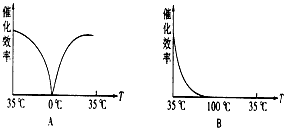如图是小麦淀粉酶在不同温度条件下的催化效率变化曲线,请据图回答:

(1)由图A可知,在_____℃时,小麦淀粉酶的催化效率最高。
(2)由图A和图B可知,在_____℃和_____℃时,催化效率都降为0;但在_____图中,随温度上升,酶催化效率可以恢复;而在另一图中,温度变化后,催化效率不再上升,这表明______________________。
(1)35
(2)0 100 A 低温使酶的活性降低,温度过高会破坏酶分子的结构,从而使酶失去活性
如图是小麦淀粉酶在不同温度条件下的催化效率变化曲线,请据图回答:

(1)由图A可知,在_____℃时,小麦淀粉酶的催化效率最高。
(2)由图A和图B可知,在_____℃和_____℃时,催化效率都降为0;但在_____图中,随温度上升,酶催化效率可以恢复;而在另一图中,温度变化后,催化效率不再上升,这表明______________________。
(1)35
(2)0 100 A 低温使酶的活性降低,温度过高会破坏酶分子的结构,从而使酶失去活性